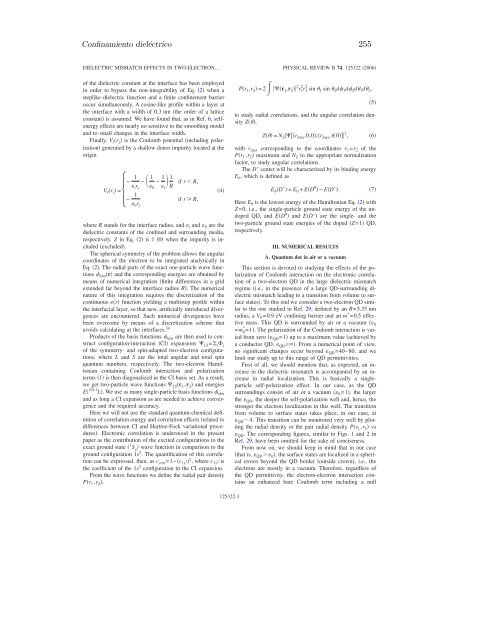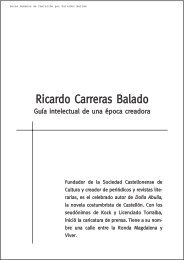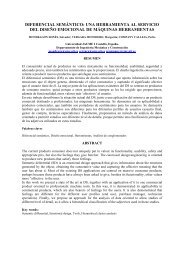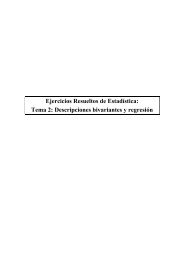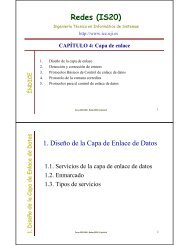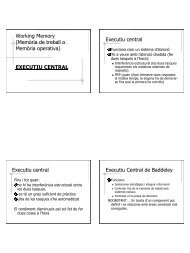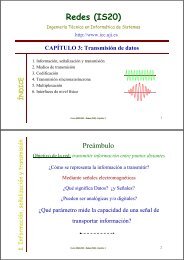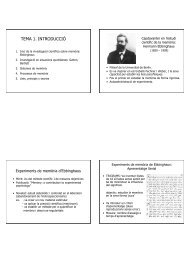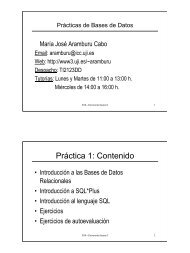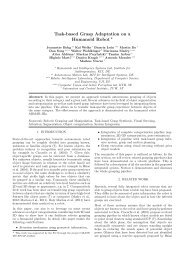254 PublicacionesJ. L. MOVILLA AND J. PLANELLES PHYSICAL REVIEW B 74, 125322 2006out. <strong>It</strong> was also shown that, under specific conditions, theattractive self-polarization potential well is able to confinecarriers in surface states, these surface states could even beenlocated on the barrier side of the interface. 27–29 On theirhand, Orlandi et al. 28 pointed out that these surface statesmay yield many-body ground state reconstructions that couldbe monitored, in turn, by transport experiments.The formation of surface states is more likely when one ofthe media involved is air or a vacuum because the depth ofthe attractive self-polarization potential well of a sphericalQD in a given medium is related to 1/ –1/ /R, and being, respectively, the higher and the lower dielectricconstants of the media involved, and R the QD radius. <strong>It</strong>should be mentioned that we recently found that the selfpolarizationwell can induce electron trapping in air-fillednanocavities of semiconductor matrices, despite the barrieractingnature of air. 30 Within these surface states the carriersundergo a strong radial localization, yielding a particular scenarioin which inter-particle Coulomb interactions can haveimportant effects on the system dynamics, as we showed inanother recent paper, 29 where the influence of image chargeson the electron correlation in two-electron spherical QDs wasthoroughly investigated. <strong>It</strong> is shown there that we may facetwo different limit situations of large dielectric mismatch inducinglocalization of both electrons in a thin sphericalcrown at the QD border. Namely, QD out and QD out .In either case, the spherical crown is located inside/outsidethe QD, respectively. When electrons are located inside theybehave almost as independent particles while outside theystrongly correlate. As the degree of confinement is similar inboth cases and the inner/outer effective masses employed inthe studied systems are of the same order, the kinetic energyshould also be similar. Hence, it is concluded that, while inthe first case the electron-electron interaction is negligible incomparison to the kinetic energy, in the second case the oppositeshould hold. 29 As the electron-electron interaction includesboth bare Coulomb plus polarization terms, what musthappen is that polarization worked against bare Coulomb inthe case of electrons inside while enforced it in the outsidecase, as can be qualitatively understood from an elementaryelectrostatic analysis. 35In this paper we will show that if the QD is highly insulatinge.g., QD 4 for a 5.35 nm QD radius confined by a0.9 eV confining barrier height, no surface states can beachieved when this QD is embedded in air or a vacuum,accordingly to previously reported results. 28,29 On bypassingthis dielectric constant threshold, a sudden increase in theangular correlation occurs as the electrons, confined in anarrow crown at the external side of the QD border, exhibit astrong tendency to avoid each other. <strong>It</strong> is then found that as QD keeps growing, a monotonous decrease in the angularcorrelation occurs. We rationalize this finding by looking atthe limit case of a conductor QD QD =, where the strongsurface positive polarization charge induced by one electronclose to its location, and the corresponding negative chargethat it also induces on the opposite site at the QD surface,work against the charge of this electron which is pushing thesecond electron away. As a result, the angular correlationdecreases. We will show that similar, but enhanced, behavioris found in a two-electron system in a spherical cavity of asemiconductor matrix. Similarities and differences betweenthe two cases are discussed. Finally, we present a comprehensivestudy on the influence of image charges on electroncorrelation and interaction energies of a weakly confined D −center two electrons bounded to a hydrogenic donor impurityin a semiconductor QD surrounded by air or a vacuum.We show that the combination of one- and two-particle contributionsof the dielectric confinement leads to different situationsin each system under study, above all when the electronicdensity is localized in a surface state.II. THEORETICAL OUTLINEWe will focus our study on the ground state 1 S g energiesand wave functions of spherical nanostructures containingtwo interacting conduction band electrons. We employ EMAand a macroscopiclike description of the screening of carriers.Thus, a parameter, the dielectric constant, characterizesthe dielectric response of each medium that is involved. Thereliability of this approach has been well established forzero-dimensional heterostructures similar to those presentedhere. 25,31The Hamiltonian for two interacting conduction bandelectrons reads, in atomic units a.u.,Hr 1 ,r 2 = H j r j + V c r 1 ,r 2 .j=1,2V c r 1 ,r 2 stands for the generalized Coulomb electronelectroninteraction, including dielectric mismatch effects.This term can be obtained by solving the Poisson equation,which presents an analytical solution for spherically symmetricQDs when a r=r steplike dielectric function is assumed.The explicit expressions for V c r 1 ,r 2 are given inRef. 6. H j r j represents the one-particle conduction bandHamiltonian of the systemH j r j =− 1 2 1m * r j + Vr j + V s r j + ZV I r j .The first term on the right-hand side of Eq. 2 representsthe variable mass hermitic kinetic energy operator. 32,33 Asteplike function is employed for the effective mass in orderto account for different masses in different materials m i * andm 0 * for the confined and the surrounding medium, respectively.Vr j is a steplike function representing the finitespatial confining potential due to the band offset between themedia involved. Since, in all the cases studied, the media areair or a vacuum and a semiconductor, the depth of theconfining well V 0 is given by the semiconductor electroaffinity.The origin of energies has been set at the bottom of thesemiconductor conduction band. V s r j stands for the selfpolarizationpotential induced by the dielectric mismatch,which can be obtained from V c r 1 ,r 2 asV s r j = 1 2 V cr j ,r j ,after excluding the bare Coulomb terms. A smooth variation123125322-2
Confinamiento dieléctrico 255DIELECTRIC MISMATCH EFFECTS IN TWO-ELECTRON…of the dielectric constant at the interface has been employedin order to bypass the non-integrability of Eq. 2 when asteplike dielectric function and a finite confinement barrieroccur simultaneously. A cosine-like profile within a layer atthe interface with a width of 0.3 nm the order of a latticeconstant is assumed. We have found that, as in Ref. 6, selfenergyeffects are nearly no sensitive to the smoothing modeland to small changes in the interface width.Finally, V I r j is the Coulomb potential including polarizationgenerated by a shallow donor impurity located at theoriginV I r j =− 1 i r j−1 0− 1 i 1 Rif r R,− 1 0 r jif r R,4where R stands for the interface radius, and i and 0 are thedielectric constants of the confined and surrounding media,respectively. Z in Eq. 2 is 1 0 when the impurity is includedexcluded.The spherical symmetry of the problem allows the angularcoordinates of the electron to be integrated analytically inEq. 2. The radial parts of the exact one-particle wave functions nlm r and the corresponding energies are obtained bymeans of numerical integration finite differences in a gridextended far beyond the interface radius R. The numericalnature of this integration requires the discretization of thecontinuous r function yielding a multistep profile withinthe interfacial layer, so that new, artificially introduced divergencesare encountered. Such numerical divergences havebeen overcome by means of a discretization scheme thatavoids calculating at the interfaces. 34Products of the basis functions nlm are then used to constructconfiguration-interaction CI expansions LS = j jof the symmetry- and spin-adapted two-electron configurations,where L and S are the total angular and total spinquantum numbers, respectively. The two-electron Hamiltoniancontaining Coulomb interaction and polarizationterms 1 is then diagonalized in the CI basis set. As a result,we get two-particle wave functions LS r 1 ,r 2 and energiesE 2S+1 L. We use as many single-particle basis functions nlmand as long a CI expansion as are needed to achieve convergenceand the required accuracy.Here we will not use the standard quantum-chemical definitionof correlation energy and correlation effects related todifferences between CI and Hartree-Fock variational procedures.Electronic correlation is understood in the presentpaper as the contribution of the excited configurations to theexact ground state 1 S g wave function in comparison to theground configuration 1s 2 . The quantification of this correlationcan be expressed, then, as c corr =1−c 1s 2 2 , where c 1s 2 isthe coefficient of the 1s 2 configuration in the CI expansion.From the wave functions we define the radial pair densityPr 1 ,r 2 ,PHYSICAL REVIEW B 74, 125322 2006Pr 1 ,r 2 =2 r 1 ,r 2 2 r 1 2 r 2 2 sin 1 sin 2 d 1 d 2 d 1 d 2 ,to study radial correlations, and the angular correlation densityZ,Z = N Z r max ,0,0,r max ,,0 2 ,with r max corresponding to the coordinates r 1 =r 2 of thePr 1 ,r 2 maximum and N Z to the appropriate normalizationfactor, to study angular correlations.The D − center will be characterized by its binding energyE b , which is defined asE b D − = E 0 + ED 0 − ED − .Here E 0 is the lowest energy of the Hamiltonian Eq. 2 withZ=0, i.e., the single-particle ground state energy of the undopedQD, and ED 0 and ED − are the single- and thetwo-particle ground state energies of the doped Z=1 QD,respectively.III. NUMERICAL RESULTSA. Quantum dot in air or a vacuumThis section is devoted to studying the effects of the polarizationof Coulomb interaction on the electronic correlationof a two-electron QD in the large dielectric mismatchregime i.e., in the presence of a large QD-surrounding dielectricmismatch leading to a transition from volume to surfacestates. To this end we consider a two-electron QD similarto the one studied in Ref. 29, defined by an R=5.35 nmradius, a V 0 =0.9 eV confining barrier and an m * =0.5 effectivemass. This QD is surrounded by air or a vacuum 0=m 0 * =1. The polarization of the Coulomb interaction is variedfrom zero QD =1 up to a maximum value achieved bya conductor QD, QD =. From a numerical point of view,no significant changes occur beyond QD =40–80, and welimit our study up to this range of QD permittivities.First of all, we should mention that, as expected, an increasein the dielectric mismatch is accompanied by an increasein radial localization. This is basically a singleparticleself-polarization effect. In our case, as the QDsurroundings consist of air or a vacuum 0 =1, the largerthe QD , the deeper the self-polarization well and, hence, thestronger the electron localization in this well. The transitionfrom volume to surface states takes place, in our case, at QD 4. This transition can be monitored very well by plottingthe radial density or the pair radial density Pr 1 ,r 2 vs QD . The corresponding figures, similar to Figs. 1 and 2 inRef. 29, have been omitted for the sake of conciseness.From now on, we should keep in mind that in our casethat is, QD 0 , the surface states are localized in a sphericalcrown beyond the QD border outside crown, i.e., theelectrons are mostly in a vacuum. Therefore, regardless ofthe QD permittivity, the electron-electron interaction containsan enhanced bare Coulomb term including a null567125322-3
- Page 1:
CONFINAMIENTO NANOSCÓPICO ENESTRUC
- Page 5 and 6:
AgradecimientosDecía Albert Einste
- Page 7:
A mi madreA la memoria de mi padre
- Page 10 and 11:
viiihigh-correlation electronic reg
- Page 12 and 13:
xric) resolution method proves the
- Page 14 and 15:
xii14. F. Rajadell, J.L. Movilla, M
- Page 16 and 17:
xivcen para moldear a voluntad su e
- Page 18 and 19:
xvideterminar las características
- Page 23 and 24:
Capítulo 1Fundamentos teóricosEl
- Page 25 and 26:
1.1 Modelo k · p 3donde p = −i¯
- Page 27 and 28:
1.1 Modelo k · p 5inversa de la ma
- Page 29 and 30:
1.2 Heteroestructuras. Aproximació
- Page 31 and 32:
1.3 Masa efectiva dependiente de la
- Page 33 and 34:
1.4 Aplicación de un campo magnét
- Page 35 and 36:
1.5 Potenciales monopartícula adic
- Page 37 and 38:
1.6 Integración numérica del hami
- Page 39 and 40:
1.7 Transiciones intrabanda 17Tras
- Page 41 and 42:
1.7 Transiciones intrabanda 19g) [7
- Page 43 and 44:
Capítulo 2Confinamientos espacial
- Page 45 and 46:
23esta aproximación asume implíci
- Page 47 and 48:
2.1 Puntos cuánticos de InAs en ma
- Page 49 and 50:
2.1 Puntos cuánticos de InAs en ma
- Page 51 and 52:
2.1 Puntos cuánticos de InAs en ma
- Page 53 and 54:
2.1 Puntos cuánticos de InAs en ma
- Page 55 and 56:
Capítulo 3Confinamiento periódico
- Page 57 and 58:
3.1 Funciones de Wannier 35otro con
- Page 59 and 60:
3.1 Funciones de Wannier 373.1.1. F
- Page 61 and 62:
3.2 Evolución temporal en modelos
- Page 63 and 64:
3.2 Evolución temporal en modelos
- Page 65 and 66:
3.2 Evolución temporal en modelos
- Page 67 and 68:
3.3 Tiempo de tunneling en cadenas
- Page 69 and 70:
3.3 Tiempo de tunneling en cadenas
- Page 71 and 72:
Capítulo 4Confinamiento magnético
- Page 73 and 74:
51donde m ∗ es la masa efectiva d
- Page 75 and 76:
4.1 Magnetización de puntos y anil
- Page 77 and 78:
4.1 Magnetización de puntos y anil
- Page 79 and 80:
4.1 Magnetización de puntos y anil
- Page 81 and 82:
4.2 Acoplamiento lateral de anillos
- Page 83 and 84:
4.2 Acoplamiento lateral de anillos
- Page 85 and 86:
4.2 Acoplamiento lateral de anillos
- Page 87 and 88:
4.2 Acoplamiento lateral de anillos
- Page 89 and 90:
Capítulo 5Confinamiento dieléctri
- Page 91 and 92:
69Más complicado pero también ana
- Page 93 and 94:
5.1 Validez de la electrodinámica
- Page 95 and 96:
5.2 Interacciones culómbicas en pu
- Page 97 and 98:
5.2 Interacciones culómbicas en pu
- Page 99 and 100:
5.3 Barreras confinantes finitas e
- Page 101 and 102:
5.3 Barreras confinantes finitas e
- Page 103 and 104:
5.3 Barreras confinantes finitas e
- Page 105 and 106:
5.3 Barreras confinantes finitas e
- Page 107 and 108:
5.4 Impurezas dadoras hidrogenoides
- Page 109 and 110:
5.4 Impurezas dadoras hidrogenoides
- Page 111 and 112:
5.4 Impurezas dadoras hidrogenoides
- Page 113 and 114:
5.4 Impurezas dadoras hidrogenoides
- Page 115 and 116:
5.4 Impurezas dadoras hidrogenoides
- Page 117 and 118:
5.4 Impurezas dadoras hidrogenoides
- Page 119 and 120:
5.4 Impurezas dadoras hidrogenoides
- Page 121 and 122:
5.4 Impurezas dadoras hidrogenoides
- Page 123 and 124:
5.4 Impurezas dadoras hidrogenoides
- Page 125 and 126:
5.4 Impurezas dadoras hidrogenoides
- Page 127 and 128:
5.4 Impurezas dadoras hidrogenoides
- Page 129 and 130:
5.5 Estados superficiales inducidos
- Page 131 and 132:
5.5 Estados superficiales inducidos
- Page 133 and 134:
5.5 Estados superficiales inducidos
- Page 135 and 136:
5.5 Estados superficiales inducidos
- Page 137 and 138:
5.5 Estados superficiales inducidos
- Page 139 and 140:
5.5 Estados superficiales inducidos
- Page 141 and 142:
5.5 Estados superficiales inducidos
- Page 143 and 144:
5.5 Estados superficiales inducidos
- Page 145 and 146:
5.5 Estados superficiales inducidos
- Page 147 and 148:
5.5 Estados superficiales inducidos
- Page 149 and 150:
5.5 Estados superficiales inducidos
- Page 151 and 152:
5.5 Estados superficiales inducidos
- Page 153 and 154:
5.5 Estados superficiales inducidos
- Page 155 and 156:
5.5 Estados superficiales inducidos
- Page 157 and 158:
5.5 Estados superficiales inducidos
- Page 159 and 160:
5.5 Estados superficiales inducidos
- Page 161 and 162:
5.5 Estados superficiales inducidos
- Page 163 and 164:
5.5 Estados superficiales inducidos
- Page 165 and 166:
5.5 Estados superficiales inducidos
- Page 167 and 168:
5.5 Estados superficiales inducidos
- Page 169 and 170:
5.5 Estados superficiales inducidos
- Page 171 and 172:
5.5 Estados superficiales inducidos
- Page 173 and 174:
5.5 Estados superficiales inducidos
- Page 175 and 176:
Capítulo 6ConclusionesEn esta Tesi
- Page 177 and 178:
155entre los anillos como la orient
- Page 179 and 180:
157fuerte decaimiento de la intensi
- Page 181 and 182:
Publicaciones
- Page 183 and 184:
Confinamientos espacial y másico
- Page 185 and 186:
Confinamientos espacial y másico 1
- Page 187 and 188:
Confinamientos espacial y másico 1
- Page 189 and 190:
Confinamientos espacial y másico 1
- Page 191 and 192:
Confinamiento periódico
- Page 193 and 194:
Confinamiento periódico 171J. Phys
- Page 195 and 196:
Confinamiento periódico 173Tunneli
- Page 197 and 198:
Confinamiento periódico 175Tunneli
- Page 199 and 200:
Confinamiento magnético
- Page 201 and 202:
Confinamiento magnético 179Symmetr
- Page 203 and 204:
Confinamiento magnético 181Aharono
- Page 205 and 206:
Confinamiento magnético 183Aharono
- Page 207 and 208:
Confinamiento magnético 185Aharono
- Page 209 and 210:
Confinamiento magnético 187PHYSICA
- Page 211 and 212:
Confinamiento magnético 189MAGNETI
- Page 213 and 214:
Confinamiento magnético 191IOP Pub
- Page 215 and 216:
Confinamiento magnético 193938Mean
- Page 217 and 218:
Confinamiento magnético 195940QRs
- Page 219 and 220:
Confinamiento dieléctrico
- Page 221 and 222:
Confinamiento dieléctrico 199Compu
- Page 223 and 224:
Confinamiento dieléctrico 201146 J
- Page 225 and 226: Confinamiento dieléctrico 203148 J
- Page 227 and 228: Confinamiento dieléctrico 205150 J
- Page 229 and 230: Confinamiento dieléctrico 207152 J
- Page 231 and 232: Confinamiento dieléctrico 209PHYSI
- Page 233 and 234: Confinamiento dieléctrico 211OFF-C
- Page 235 and 236: Confinamiento dieléctrico 213OFF-C
- Page 237 and 238: Confinamiento dieléctrico 215OFF-C
- Page 239 and 240: Confinamiento dieléctrico 217PHYSI
- Page 241 and 242: Confinamiento dieléctrico 219BRIEF
- Page 243 and 244: Confinamiento dieléctrico 221PHYSI
- Page 245 and 246: Confinamiento dieléctrico 223TRAPP
- Page 247 and 248: Confinamiento dieléctrico 225Deloc
- Page 249 and 250: Confinamiento dieléctrico 227V s (
- Page 251 and 252: Confinamiento dieléctrico 229with
- Page 253 and 254: Confinamiento dieléctrico 231value
- Page 255 and 256: Confinamiento dieléctrico 233(R in
- Page 257 and 258: Confinamiento dieléctrico 23525R i
- Page 259 and 260: Confinamiento dieléctrico 237monoe
- Page 261 and 262: Confinamiento dieléctrico 239[8] Y
- Page 263 and 264: Confinamiento dieléctrico 241[48]
- Page 265 and 266: Confinamiento dieléctrico 243PHYSI
- Page 267 and 268: Confinamiento dieléctrico 245FROM
- Page 269 and 270: Confinamiento dieléctrico 247PHYSI
- Page 271 and 272: Confinamiento dieléctrico 249THEOR
- Page 273 and 274: Confinamiento dieléctrico 251THEOR
- Page 275: Confinamiento dieléctrico 253PHYSI
- Page 279 and 280: Confinamiento dieléctrico 257DIELE
- Page 281 and 282: Confinamiento dieléctrico 259DIELE
- Page 283 and 284: Confinamiento dieléctrico 261DIELE
- Page 285 and 286: Confinamiento dieléctrico 263PHYSI
- Page 287 and 288: Confinamiento dieléctrico 265FAR-I
- Page 289 and 290: Confinamiento dieléctrico 267FAR-I
- Page 291 and 292: Confinamiento dieléctrico 269Diele
- Page 293 and 294: Confinamiento dieléctrico 271Diele
- Page 295 and 296: Confinamiento dieléctrico 273Diele
- Page 297 and 298: Confinamiento dieléctrico 275Diele
- Page 299 and 300: Confinamiento dieléctrico 277Diele
- Page 301 and 302: Confinamiento dieléctrico 279Diele
- Page 303 and 304: Confinamiento dieléctrico 281Diele
- Page 305 and 306: Confinamiento dieléctrico 283Diele
- Page 307 and 308: Confinamiento dieléctrico 285Diele
- Page 309 and 310: Confinamiento dieléctrico 287Diele
- Page 311 and 312: Confinamiento dieléctrico 289Diele
- Page 313 and 314: Confinamiento dieléctrico 291Diele
- Page 315 and 316: Bibliografía[1] J. Karwowski,“In
- Page 317 and 318: BIBLIOGRAFÍA 295[23] J.L. Movilla,
- Page 319 and 320: BIBLIOGRAFÍA 297[48] M.G. Burt,
- Page 321 and 322: BIBLIOGRAFÍA 299[71] W.H. Press, S
- Page 323 and 324: BIBLIOGRAFÍA 301[97] U.H. Lee, D.
- Page 325 and 326: BIBLIOGRAFÍA 303[121] S.W. Chung,
- Page 327 and 328:
BIBLIOGRAFÍA 305[145] R. Blossey y
- Page 329 and 330:
BIBLIOGRAFÍA 307[169] F. Suárez,
- Page 331 and 332:
BIBLIOGRAFÍA 309[194] C. Delerue,
- Page 333 and 334:
BIBLIOGRAFÍA 311[220] J.L. Zhu y X
- Page 335 and 336:
BIBLIOGRAFÍA 313[245] L.M. Peter,
- Page 337 and 338:
BIBLIOGRAFÍA 315[266] P. Rinke, K.
- Page 339 and 340:
BIBLIOGRAFÍA 317[289] Y. Wang, L.
- Page 341 and 342:
BIBLIOGRAFÍA 319[314] A. Wójs y P


